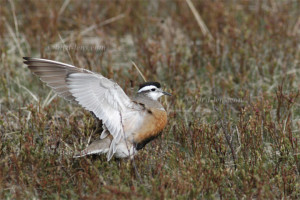 A bleak agricultural prairie in a low mountain range of Germany. The gaze falls on monotonous furrows. Only on the horizon forest can be discerned. The area seems to be empty of birds. Only at some distance a Eurasian Kestrel (Falco tinnunculus) is circling in the air. Nevertheless, this kind of habitat can be of great importance ornithological-wise. After a while, you might hear a trilling call, a melancholy “pjurrr”. Now it is time to watch-out carefully. Intense screening of suitable areas with binoculars or spotting scope to spot resting Eurasian dotterel (Eudromias morinellus) usually results only with a lot of time and patience in success. Due to the excellent camouflage of the resting birds you cannot expect fast sightings. Once you have discovered a Dotterel, it is relatively easy to determine the bird. In non-breeding plumage Eurasian dotterel may – under certain circumstances – be confused with the European Golden-Plover (Pluvialis apricaria). Dotterel in breeding plumage, however, are not to be confused with any other species to be expected in Germany. The following tips should help in determining ID-characteristics of the birds.
A bleak agricultural prairie in a low mountain range of Germany. The gaze falls on monotonous furrows. Only on the horizon forest can be discerned. The area seems to be empty of birds. Only at some distance a Eurasian Kestrel (Falco tinnunculus) is circling in the air. Nevertheless, this kind of habitat can be of great importance ornithological-wise. After a while, you might hear a trilling call, a melancholy “pjurrr”. Now it is time to watch-out carefully. Intense screening of suitable areas with binoculars or spotting scope to spot resting Eurasian dotterel (Eudromias morinellus) usually results only with a lot of time and patience in success. Due to the excellent camouflage of the resting birds you cannot expect fast sightings. Once you have discovered a Dotterel, it is relatively easy to determine the bird. In non-breeding plumage Eurasian dotterel may – under certain circumstances – be confused with the European Golden-Plover (Pluvialis apricaria). Dotterel in breeding plumage, however, are not to be confused with any other species to be expected in Germany. The following tips should help in determining ID-characteristics of the birds.
Dotterel in breeding plumage are characterized by the bright white superciliar stripe. On chest and belly they showy a reddish-brown color. A narrow white chest band is very typical. Moulting birds in the plumage, fade all the colors, the belly is yellowish to white blotchy. At that time a chest ring is far less noticeable. Juvenile individuals or Eurasian dotterels in non-breeding plumage are to be confused with European Golden-Plovers. Of the bigger plovers (Pluvialis sp.) the Eurasian dotterel is the most likely encountered species inland. This is especially true on the narrow time window on arable land away from the coasts. The best distinguishing feature is the long, white or warm-brown superciliar stripe converging on the neck. European Golden-Plover are also lacking the whitish breast band, but this is not always obvious by Dotterels as well. Both species differ in leg color, too: While Eurasian dotterels show yellowish to greenish-grey legs, the legs of European Golden-Plovers are dark grey. Only rarely they mix with other waders (e.g. European Golden-Plover (Pluvialis apricaria)).
With these ID-characteristics in mind, a Dotterel can hardly be confused with any other species in Middle Europe. The Eurasian dotterel (Charadrius morinellus) is a member of the plover family which migrates from northern Europe, where it breeds, to North Africa, where it winters.
In a roosting place they often behave quite familiar and usually persist even on a few meters distance. However, larger flocks are sometimes shy and fly away even in case of low interference.
To cope with the growing demand for top shots of the rarer species of the Palearctic Bird-Lens.com is keen to enrich the range of pictures of birds you can find in the western Palearctic. Trips to productive locations in Germany but also to remote places in the world to capture images of rare birds of western Palearctic were very successful. The nice image of the blog was shot in the northern part of Finland where the Dotterel is shown on its breeding ground. This image is only a first impression, what you will find in the gallery in the “Picture Shop” very soon. Just give a message, if bird-lens.com could serve you with an image needed before the new pictures are online.